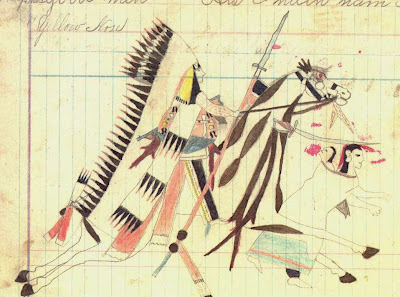In a place like the arid American Southwest any place where water is found is a memorable and highly prized location. Symbols that are associated with such places would also be considered important. One symbol that inevitably comes to mind around water in the Southwest is the dragonfly. Dragonflies, in addition to being associated with water, are also definitely sky beings. For some Native American tribes they represent swiftness and activity. They are commonly portrayed in Native American art as a vertical line with a double crossbar.
Shield, and dragonfly, Galisteo dike, NM.
Photo Peter Faris, 1988.
The image of the dragon fly from Galisteo Dike was produced by ancestral Pueblo people. These images are fairly common in the southwest. In this location it is associated with other images including sky symbolism. There is a 4-pointed star, a bird, and a shield decorated with stars and sun images. As a sky being the association of the dragonfly with sky symbols makes sense. Adding all of this to its association with water we should expect that the dragonfly symbol would be popular in rock art of the region.
Yellow Nose with Dragonfly shield, National Anthropological
Archive, Smithsonian Institution. MS. 166032.
Tribes of the Great Plains also see desirable military qualities in the dragonfly. Its straight flight can be reminiscent of the flight of an arrow and its quick zigzag darting makes it hard for an enemy to strike. The Cheyenne warrior Yellow Nose had these qualities in mind when he painted a dragonfly on his war shield.
Navajo dragonfly. Redrawn from Kritsky and
Cherry, Insect Mythology, 2000, p. 109.
The Zuni regard the dragonfly as possessing supernatural power and killing one is supposedly forbidden. Because of its shape the Zunis also see a resemblance to an awl used for leatherworking and Dragonfly Kachina is associated with moccasin making and sewing. They appear in Hopi rock art, and on Pueblo necklaces. For the Navajo they symbolize pure water.







No comments:
Post a Comment